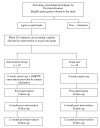Does self-management for return to work increase the effectiveness of vocational rehabilitation for chronic compensated musculoskeletal disorders? Protocol for a randomised controlled trial
- PMID: 20534168
- PMCID: PMC2893451
- DOI: 10.1186/1471-2474-11-115
Does self-management for return to work increase the effectiveness of vocational rehabilitation for chronic compensated musculoskeletal disorders? Protocol for a randomised controlled trial
Abstract
Background: Musculoskeletal disorders are common and costly disorders to workers compensation and motor accident insurance systems and are a leading contributor to the burden of ill-health. In Australia, vocational rehabilitation is provided to workers to assist them to stay in, or return to work. Self-management training may be an innovative addition to improve health and employment outcomes from vocational rehabilitation.
Methods/design: The research plan contains mixed methodology consisting of a single blind randomised controlled trial, an economic evaluation and qualitative research. Participants (n = 366) are volunteers with compensated musculoskeletal disorders of 3 months to 3 years in duration who were working at the time of the injury/onset of the chronic disorder. The trial tests the effectiveness of usual vocational rehabilitation plus the Chronic Disease Self-Management Program (CDSMP) to which two additional and newly-developed modules have been added, against vocational rehabilitation alone (control) The modules added to the CDSMP focus on how to navigate through compensation systems and manage the return to work process, and aim to be relevant to those in a vocational rehabilitation setting.The primary outcome of this study is readiness for return to work which will be evaluated using the Readiness for Return-to-Work scale. Secondary outcomes include return to work status, health efficacy (heiQ questionnaire) and general health status (SF-12v2(R) Health Survey). Measures will be taken at baseline, immediately post-intervention and at 6- and 12- months post-intervention by an independent assessor. An economic evaluation will compare the costs and outcomes between the intervention and control groups in terms of cost-effectiveness and a partial cost-benefit or cost analysis. The impact of the intervention will also be evaluated qualitatively, in terms of its acceptability to stakeholders.
Discussion: This article describes the protocol for a single blind randomised controlled trial with a one year follow-up. The results will provide evidence for the addition or not of self-management training within vocational rehabilitation for chronic compensated musculoskeletal disorders.
Trial registration: Australia and New Zealand Clinical Trials Registry ACTRN12609000843257.
Figures
Similar articles
-
Implementing a self-management intervention for people with a chronic compensable musculoskeletal injury in a workers compensation context: a process evaluation.J Occup Rehabil. 2015 Jun;25(2):412-22. doi: 10.1007/s10926-014-9551-4. J Occup Rehabil. 2015. PMID: 25385198
-
Cost-effectiveness of a participatory return-to-work intervention for temporary agency workers and unemployed workers sick-listed due to musculoskeletal disorders: design of a randomised controlled trial.BMC Musculoskelet Disord. 2010 Mar 28;11:60. doi: 10.1186/1471-2474-11-60. BMC Musculoskelet Disord. 2010. PMID: 20346183 Free PMC article. Clinical Trial.
-
Cost-effectiveness of 40-hour versus 100-hour vocational rehabilitation on work participation for workers on sick leave due to subacute or chronic musculoskeletal pain: study protocol for a randomized controlled trial.Trials. 2015 Jul 28;16:317. doi: 10.1186/s13063-015-0861-4. Trials. 2015. PMID: 26215748 Free PMC article. Clinical Trial.
-
Systematic reviews of the effectiveness of day care for people with severe mental disorders: (1) acute day hospital versus admission; (2) vocational rehabilitation; (3) day hospital versus outpatient care.Health Technol Assess. 2001;5(21):1-75. doi: 10.3310/hta5210. Health Technol Assess. 2001. PMID: 11532238 Review.
-
Applying principles of self-management to facilitate workers to return to or remain at work with a chronic musculoskeletal condition.Man Ther. 2013 Aug;18(4):274-80. doi: 10.1016/j.math.2013.04.001. Epub 2013 May 2. Man Ther. 2013. PMID: 23643482 Review.
Cited by
-
Implementing a self-management intervention for people with a chronic compensable musculoskeletal injury in a workers compensation context: a process evaluation.J Occup Rehabil. 2015 Jun;25(2):412-22. doi: 10.1007/s10926-014-9551-4. J Occup Rehabil. 2015. PMID: 25385198
-
Spinal pain: current understanding, trends, and the future of care.J Pain Res. 2015 Oct 23;8:741-52. doi: 10.2147/JPR.S55600. eCollection 2015. J Pain Res. 2015. PMID: 26604815 Free PMC article. Review.
-
Return-to-work coordination programmes for improving return to work in workers on sick leave.Cochrane Database Syst Rev. 2017 Mar 30;3(3):CD011618. doi: 10.1002/14651858.CD011618.pub2. Cochrane Database Syst Rev. 2017. PMID: 28358173 Free PMC article.
-
A self-management program for employees with complaints of the arm, neck, or shoulder (CANS): study protocol for a randomized controlled trial.Trials. 2013 Aug 16;14:258. doi: 10.1186/1745-6215-14-258. Trials. 2013. PMID: 23958154 Free PMC article. Clinical Trial.
References
-
- Australian Institute of Health and Welfare. Arthritis and musculoskeletal conditions in Australia 2005. With a focus on osteoarthritis, rheumatoid arthritis and osteoporosis. AIHW CAT. NO. PHE 67. 2005.
-
- Australian Safety and Compensation Council. Compendium of workers' compensation statistics Australia 2006-07. Canberra: Australian Government; 2009.
-
- Accident Compensation Corporation. New Zealand Acute Low Back Pain Guide incorporating the guide to assessing psychosocial yellow flags in acute low back pain. 2004.
-
- International Labour Organisation. Vocational rehabilitation and employment of disabled persons. International Labour Conference 86th Session. 1998.
Publication types
MeSH terms
LinkOut - more resources
Full Text Sources


